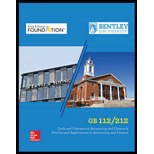
1.
Calculate the issuance price of the bonds on January 1 of this Year.
1.
Explanation of Solution
Bonds Payable: Bonds payable are referred to long-term debts of the business, issued to various lenders known as bondholders, generally in multiples of $1,000 per bond, to raise fund for financing the operations.
Effective-interest method of amortization: It is an amortization model that apportions the amount of bond discount or premium based on the market interest rate.
Present Value: The current value of an amount that is to be paid or received in future is called as present value.
Determine the issuance price of the bonds.
Step 1: Calculate the cash interest payment for bonds.
Step 2: Calculate the present value of cash interest payment.
| Particulars | Amount |
| Interest payment (a) | $18,750,000 |
| PV factor at annual market interest rate of 2% for 20 periods (b) | 16.35143 |
| Present value | $306,589,313 |
Table (1)
Note: The present value factor for 20periods at 2% interest would be 16.35143 (Refer Appendix E (Table E.2) in the book for present value factor).
Step 3: Calculate the present value of single principal payment of $750,000,000 (principal amount) at 2% for 20 periods.
| Particulars | Amount |
| Single principal payment (a) | $750,000,000 |
| PV factor at annual market interest rate of 2% for 20 periods (b) | 0.67297 |
| Present value | $504,727,500 |
Table (2)
Note: The present value factor for 20periods at 2% interest would be 0.67297 (Refer Appendix E (Table E.1) in the book for present value factor).
Step 4: Calculate the issue price of the bonds.
Hence, The issuance price of the bondson January 1 of this Year is $811,316,813.
2.
Calculate the amount of interest expense that should be recorded on June 30 of this year.
2.
Explanation of Solution
Bonds: Bonds are long-term promissory notes that are issued by a company while borrowing money from investors to raise fund for financing the operations.
Interest Expense: The cost of debt which is occurred during a particular period of time is called interest expense. The interest amount is payable on the principal amount of debt at a fixed interest rate.
Calculate the amount of interest expense that that should be recorded on June 30 of this year.
Hence, amount of interest expense that should be recorded on June 30 of this year is $16,226,336.
Calculate the amount of interest expense that should be recorded on December 31 of this year.
Explanation of Solution
Bonds: Bonds are long-term promissory notes that are issued by a company while borrowing money from investors to raise fund for financing the operations.
Interest Expense: The cost of debt which is occurred during a particular period of time is called interest expense. The interest amount is payable on the principal amount of debt at a fixed interest rate.
Calculate the amount of interest expense that that should be recorded on December 31 of this year.
Hence, amount of interest expense that should be recorded on December 31 of this year is $16,175,863.
3.
Calculate the amount of cash that should be paid to investors on June 30 of this year.
3.
Explanation of Solution
Bonds: Bonds are long-term promissory notes that are issued by a company while borrowing money from investors to raise fund for financing the operations.
Calculate the amount of cash that should be paid on June 30 of this year.
Hence, amount of cash that should be paid on June 30 of this year is $18,750,000.
Calculate the amount of cash that should be paid on December 31 of this year.
Explanation of Solution
Bonds: Bonds are long-term promissory notes that are issued by a company while borrowing money from investors to raise fund for financing the operations.
Calculate the amount of cash that should be paid on December 31 of this year.
Hence, amount of cash that should be paid on December 31 of this year is $18,750,000.
4.
Calculate the book value of the bonds on June 30 of this year.
4.
Explanation of Solution
Bonds: Bonds are long-term promissory notes that are issued by a company while borrowing money from investors to raise fund for financing the operations.
Determine the book value of the bonds on June 30 of this year.
Hence, the book value of the bonds on June 30 of this year is $808,793,149.
Calculate the book value of the bonds on December 31 of this year.
Explanation of Solution
Bonds: Bonds are long-term promissory notes that are issued by a company while borrowing money from investors to raise fund for financing the operations.
Determine the book value of the bonds on December 31 of this year.
Hence, the book value of the bonds on December 31 of this year is $806,219,012.
Want to see more full solutions like this?
Chapter 10 Solutions
GB 112/212 MANAGERIAL ACC. W/ACCESS >C<
- no aiOne company might depreciate a new computer over three years while another company might depreciate the same model computer over five years...and both companies are right. True Falsearrow_forwardno ai An asset's useful life is the same as its physical life? True Falsearrow_forwardno ai Depreciation Expense reflects an allocation of an asset's original cost rather than an allocation based on the economic value that is being consumed. True Falsearrow_forward
- The purpose of depreciation is to have the balance sheet report the current value of an asset. True Falsearrow_forwardDepreciation Expense shown on a company's income statement must be the same amount as the depreciation expense on the company's income tax return. True Falsearrow_forwardDont use AI Give soln.arrow_forward
 Financial AccountingAccountingISBN:9781305088436Author:Carl Warren, Jim Reeve, Jonathan DuchacPublisher:Cengage Learning
Financial AccountingAccountingISBN:9781305088436Author:Carl Warren, Jim Reeve, Jonathan DuchacPublisher:Cengage Learning

